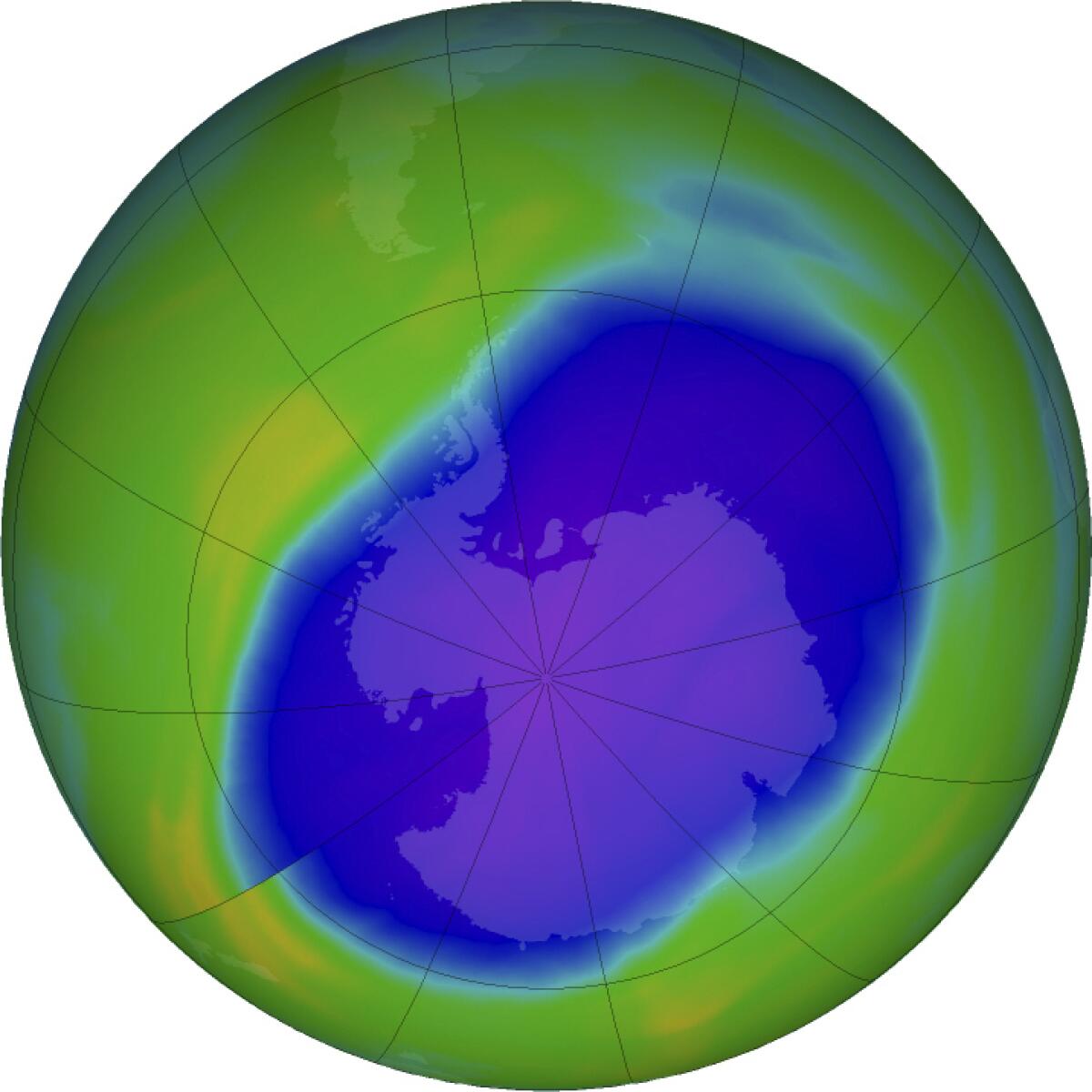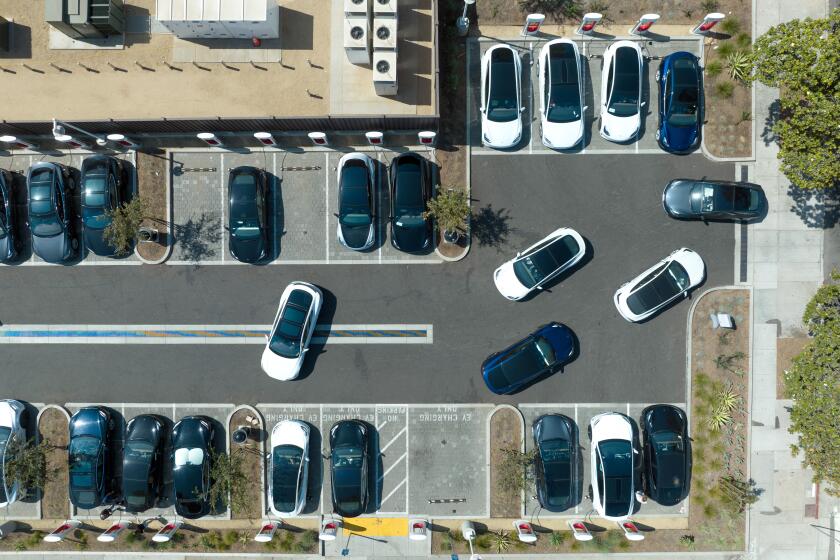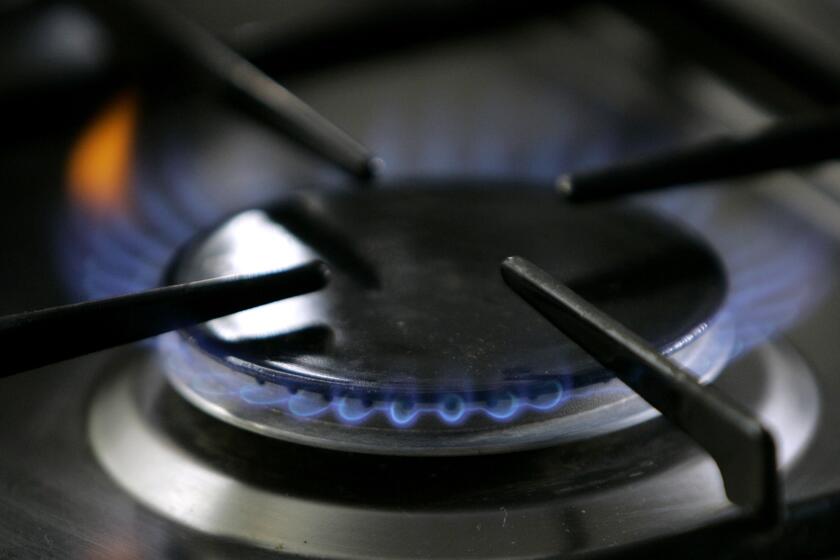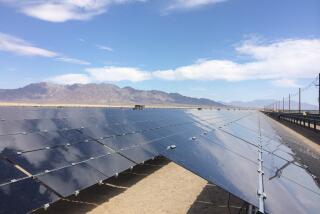Editorial: The healing of the ozone layer gives hope, but addressing climate change will be harder

Now for some good news about our planet: The ozone layer is healing.
A recent United Nations-backed assessment found continued progress in the global effort to repair the shield-like layer high up in the stratosphere that protects Earth and its inhabitants from harmful ultraviolet radiation that causes skin cancer and hurts plants and animals. The ozone layer is now on track to be restored to 1980s levels over much of the world by 2040, over the Arctic by 2045 and the Antarctic by 2066.
The gradual recovery of the ozone layer has been held up as proof that humanity can succeed with sustained, collective action against a shared threat to our environment. So should it also give us hope for the climate crisis? Not if we ignore its example and continue with the same plodding rate of action.
Nearly 1 in 5 new car sales in California were zero-emission in 2022, but most of them are Teslas and other high-end models. That shows how far the state has to go in making the shift to electric vehicles equitable.
The progress scientists have measured is a direct result of the 1987 Montreal Protocol, a treaty approved by every country in the world outlawing chemicals that eat away at the ozone layer, including chlorofluorocarbons that were once used in canned aerosol sprays and refrigerants. Nearly 99% of those banned ozone-depleting chemicals have now been phased out, according to the report.
If international cooperation is working successfully to reverse the thinning of the ozone layer, it stands to reason that multilateral efforts could also prove successful in the fight against climate change and fossil fuels. Or as World Meteorological Organization Secretary-General Petteri Taalas said in a statement announcing the report, âozone action sets a precedent for climate action.â
The news is encouraging, but the comparison works only up to a point. Curbing global warming is a far more difficult and an all-encompassing task, requiring us to replace the burning of fossil fuels that are at the center of the global economy with clean renewable energy, while reversing the destruction of forests and other ecosystems that store carbon.
Across California utility bills are skyrocketing as natural gas prices spike. The volatility underscores the need to shift quickly to renewable energy.
Fossil fuels are also far more ubiquitous in our society than the chemicals that caused ozone depletion, with fewer applications, mostly in air conditioning and refrigeration, as propellants in aerosol cans and in foams and solvents, and were replaced over time with ozone-safe alternatives with little disruption to the economy. Oil and gas are piped and shipped across nations and pumped into our vehicles and homes. Petrochemicals are widespread in the products we use daily. Practically every kind of consumption â from the food we eat to the vehicles we use â contributes to climate change.
The good news is we already know the solutions and have the technology needed to switch to renewable energy. But to succeed in curbing climate change, humanity will have to overcome powerful, entrenched fossil fuel interests and their beholden politicians. These industries have engaged in decades-long disinformation campaigns to delay climate action and try to cling to their profits for as long as possible.
Weâve certainly seen some progress, including the growth of solar, wind and other renewable energy, the rapid expansion of electric vehicles and the passage of the Inflation Reduction Act. But overall, climate action has been slow, and still isnât happening at anywhere near the scale or urgency needed.
New data on global temperatures and U.S. emissions show that despite some recent progress on climate policy, weâre still on a reckless path in the wrong direction. Leaders need to do more, fast.
It took only about two years after the discovery of the Antarctic ozone hole for global leaders to adopt the Montreal Protocol, showing how quickly the world can come together to confront an environmental threat. But with climate change, scientists have known for decades that greenhouse gas pollution is dangerously heating up the planet. Yet global leaders are still largely dithering, making only incremental progress when we need to be racing to avert catastrophic warming. At last yearâs U.N. climate summit in Egypt, the worldâs nations could only agree on a pathetically weak agreement calling for a âphasedown of unabated coal powerâ when it is obvious the solution is to quickly phase out all fossil fuels.
Itâs possible that decades from now we will be celebrating the near-elimination of fossil fuels and tracking the recovery of the atmosphere from our reckless dumping of greenhouse gases.
But hoping so isnât enough. We have all the tools we need to fight this existential threat and we now know that taking decisive action can get results. We canât wait a moment longer to act.
More to Read
Toward a more sustainable California
Get Boiling Point, our newsletter exploring climate change, energy and the environment, and become part of the conversation â and the solution.
You may occasionally receive promotional content from the Los Angeles Times.













